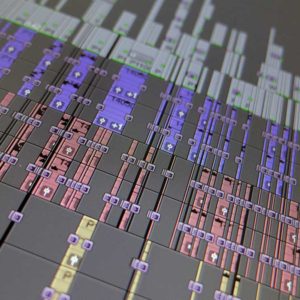I enjoy working on music-based projects and music videos. I’ve worked as a video producer, director, cameraman and post-production editor whilst at the BBC and as a freelancer. I share my freelance video production perspective to help anyone who might be thinking of creating a music video.

18 creative and technical points to consider
The easiest way to explain how to make a music video is for me to list the main elements that you are going to need to consider early on in the process.
1.The music track
Hopefully, you are going to choose to work with a music track that you like and believe in. You will need the permission of the music artist(s) and or copyright holders of the composition, i.e. the writer of any lyrics or music and for the performance. It’s going to easier for you to make a video for a friend or an unsigned artist (one that is unsigned and not subject to the small c and p that you see on copyright-protected music labels). This would hopefully avoid the issue of copyright and gaining copyright clearances from copyright-protected material.
2. A concept or story to base your visuals on
There are loads of ways in which you could make a music video. You could, of course, just film beautiful abstract visuals and edit them to the music track. Or you might like to develop a story that adds to the soundtrack or music lyrics. Either way, a good idea is to write a shot list or storyboard in advance of filming so that you have a good idea of the shots that you will need to film. This will also help you to work out how many days filming you will need and the shooting schedule.
3. An idea of the videos look and style
As well as the story consider the visual aesthetic and style of how you want it all to look. Having an overall creative vision for the music video at the start will enable you to realise that vision as all the elements involved combine. The pace of the music and the editing could affect how much footage you need to film. A faster-paced edit may require more shots than a slower edited video. During the process of the production, new ideas will arise that might move the creative vision in a different direction so be open to different views along the way.
4. Locations to film
Once you have your concept or story, you will have a better idea of the type and amount of locations you will need. One of the things to consider is whether you have permission to film at your chosen locations or if you will need to obtain permission. You could choose to hire a studio for filming, use a private space or film in public areas. Consider if the locations have everything you need for the shoot.
5. The talent – actors, performers and artists
Unless your video does not feature people, you will need to consider who is in it. Will you be highlighting the group or individual responsible for creating the music track or singing in the song? Or will you feature actors or friends acting out a role? You need to decide who will be in the video and get them to sign a talent release form for the production you are working on. How much do you need to pay these people?
6. A team of people with organisational, technical and creative skills
Unless you are making the whole video on your own, you might need to work with a group of people who can help you realise your vision. Essential skills could include a producer, director, costume designer, lighting designer, movement director, a camera person, hair and make-up artists and post-production editor. You might decide to work with people that you know, or your network knows with the particular skills you need. There are many filming community forums where people advertise the roles they are looking for, including www.Mandy.com. Consider how much do you need to pay these people. Also, consider how much they would charge for their equipment and services?
7. Lighting
How are you lighting the shoot? Unless you are filming the whole video outside in natural sunlight, you will need to consider using additional artificial lighting. Your lighting designer and camera team will be able to advise you further with this. You might need extra power supplies if filming with a large amount of mains powered lights. Good lighting is key to making your filmed images look great.
8. Props
Once you have got a sense of the video visuals and story, you can start to consider what accessories you might need for the shoot. By carefully planning each scene and the actions within it, you will be able to write a list of required props. Some of these you will able to source from your network of friends and colleagues. You might need to source some items from specialist prop hire companies or even get bespoke items specially made.
9. Costume, hair and make-up
Thinking about the people being filmed and how you want them to look will help you understand your costume, make-up and hairdressing requirements. Do you need any prosthetics, wigs and specially made or hired costumes? All of these elements take time to organise; either apply or get dressed in and can affect the actual filming schedule. By planning each scene or set-up, you will be prepared.
10. Hired in equipment
Consider the kit list of equipment you want to use. Will you need to hire a camera or additional cameras with enough data cards for the shoot? Will you hire any other lenses? What about camera support like tripods, Steadicam, motion rigs and other camera mounting devices? The right wattage and the correct type of lighting for the location and size of your shoot (with enough cables)? What about a monitor to check its all looking great?
11. Graphics, editing and post-production
Will the music video require any specially made graphics, animations, visual effects or text elements? Will you be filming any green screen footage for chroma keying? Talking the project through with a vfx or post-production expert at the beginning could help your production realise its full creative vision. Some complex visual effect might benefit from footage being filmed in a specific way. Knowing this at the start of the process will also help you manage your filming schedule efficiently. You might want to commission any specific graphics early on so that they can be signed-off and delivered in time for the start of the editing process.
12. Delivery and broadcast
If you are looking to offer your music video for transmission on a major channel, then you will need to deliver the final edited digital file to the channels technical specifications. Each channel will publish a set of technical specifications available for you to view online. If you want to post the video on YouTube, you will need to make sure no one else owns the copyright for the music (or any of the images used) otherwise you may be asked to remove the video.
13. Promotion
Consider how you are going to promote the music video. Will you be selling the track online or on iTunes? Will the video form part of a marketing campaign? Are you planning to release any merchandise linked to the video? What is your marketing strategy? What type of social networks will you share it on? Do you need any links to buy the track on the video end board or in the YouTube description?
14. Making of video
Have you thought about creating a making-of video during the production process? This could help promote the music video differently. It could also be helpful to encourage the team and technical skills used in the project. The extra-filmed footage could also be a way to help you gain the support of other business like camera, lighting and grip equipment suppliers for example. Creating this additional footage will take extra time and resources so allow for that across the whole production and post-production process.
15. Budget
By considering all the above factors, you will be able to determine the range of costs involved in your video production. Also, you need to think about all the additional expenses like transport and food that will occur during video production. Of course, it may be possible for you to save money by using resources that are available to you free of charge.
16. Funding and support opportunities
If it’s an underfunded or self-funded project, you may be looking to increase the budget available for your production. Kickstarter and many of the online social networks like Facebook are a great place to gain support for your project. Your own family and friends can be the best place to start if it’s your first project. It is also possible to get help with equipment and locations by adding a credit for your supporters at the end of your music video. More commercially aware production companies are also using product placement to gain support for their projects.
17. Schedule and planning
Being highly organised and planning everything well will help you manage the team and video production process. Consider scheduling rehearsals at the locations you plan to film with the complete team. This will help flag up any shortcomings not currently addressed.
18. Protecting your work
When shooting original video content, you should consider protecting the rights to your creative work. If you are shooting people, then you might like them to sign a disclosure form that then waives their rights to any future claims on the material. This will ensure that you have permission to use the filmed footage for the agreed use. If you have any questions or would like help with your project, please get in touch.
You might find some of these related articles useful. For more advice and tips check out my video production blog.



